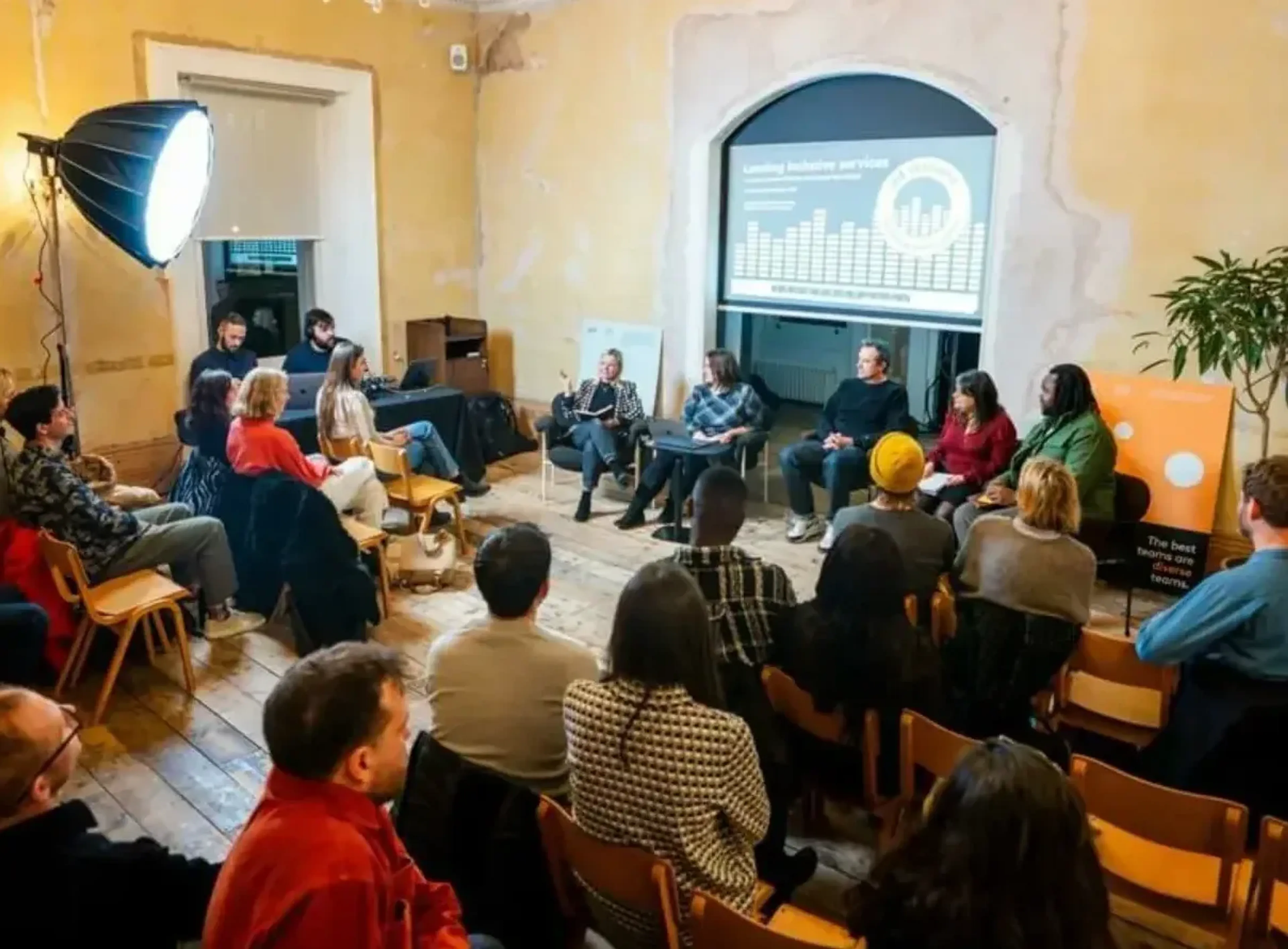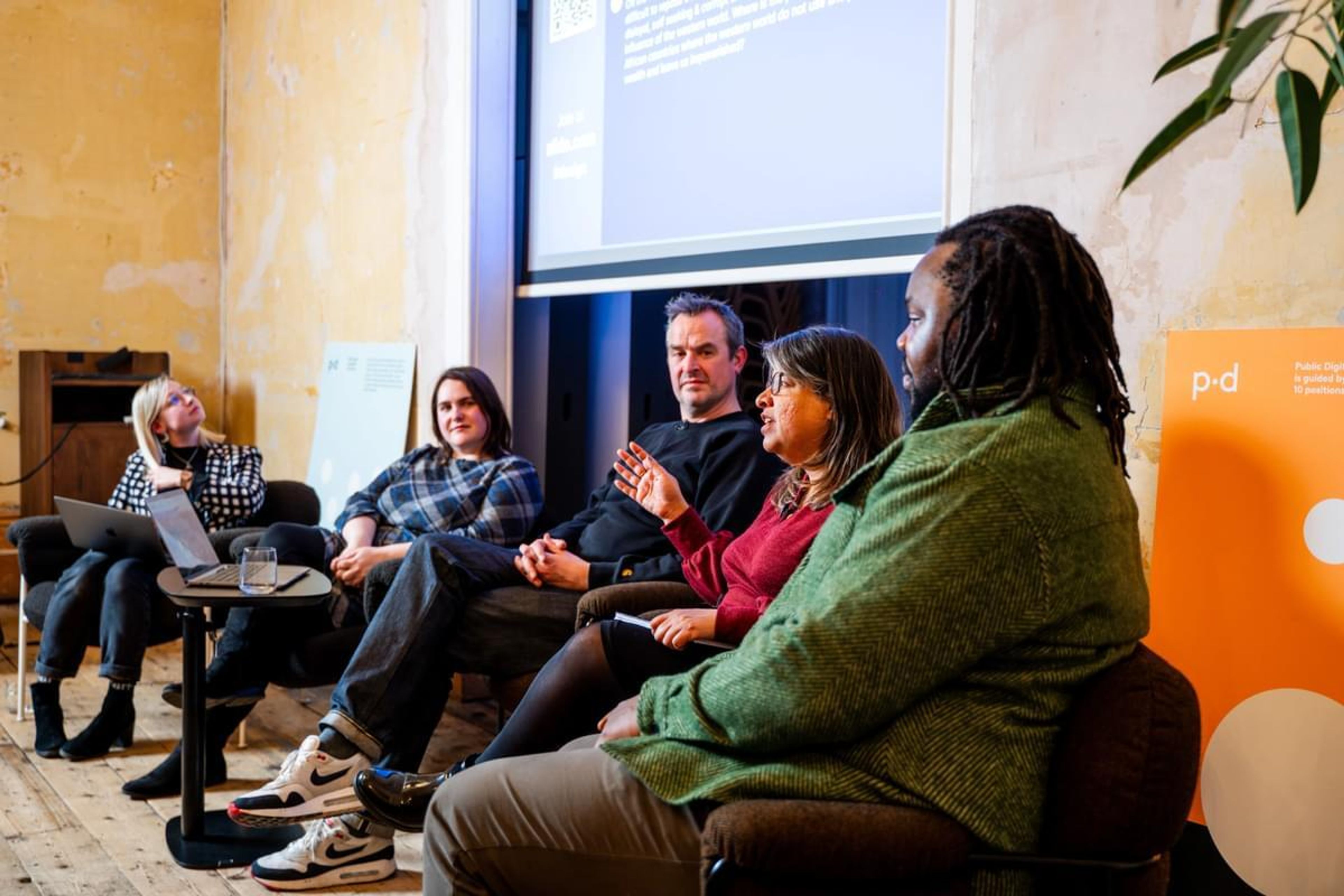PD Sessions: Leading Inclusive Services
Last Wednesday we hosted our first PD Sessions event of the year, exploring leading inclusive services.
Inclusivity is too often deprioritised in service design across both the public and private sector. In this session our panel examined why it matters, how leaders and practitioners can make the case for it within their organisations, and how we can rethink our approach to inclusivity in order to see meaningful change.
To discuss these questions, we were joined by Alistair Duggin, Principal Accessibility Specialist at TetraLogical, Piali Das Gupta a Strategy Director at London's Future at London Councils, and Julian Thompson, founder and CEO of Rooted by Design. Also on the panel was PD Director, Audree Fletcher.
The range and degree of expertise on the panel was humbling, and it was a pleasure to host a conversation with so much insight on a complex topic.

Inclusivity as a 'nice to have'
Despite being a moral and legal imperative in the public sector, and a business imperative in the private sector, inclusivity is often considered a ‘nice to have’.
These were the findings of PD Director, Audree, who began the session by relating her experience as Service Director at NHS Test and Trace, where she was also responsible for its organisation-wide equity and inclusion programme.
When Audree arrived at Test and Trace it was clear to her that the early design of the services best met the needs of the most privileged - and worked least well for traditionally underserved, excluded and disenfranchised groups. Unfortunately it was these latter communities that Test and Trace needed to be serving most because they were often in areas where COVID transmission was stubbornly enduring.
To drive up uptake in these communities, Audree and her teams transformed what and how they were delivering by moving beyond a compliance mindset for accessibility and inclusion, by bridging the gap between decision-makers and communities, and by focusing on building trust.
Moving beyond the compliance mindset
UK public sector digital interfaces are legally required to be accessible. There is a requirement to meet the Web Content Accessibility Guidelines (WCAG) which involves the service being demonstrably operable, understandable and robust. While these guidelines can be a positive force in compelling public sector organisations to consider access in their digital service design, they also bring problems.
Alistair gave us an insight into what those problems are, and how they can be overcome. As former Head of Accessibility at the Government Digital Service and consultant at TetraLogical, an accessibility consultancy that focuses on inclusion, he is a leading voice on inclusivity in public services.
Alistair spoke about the role of the WCAG in creating a compliance mindset, where meeting the guidelines - which is the bare minimum - becomes the goal. Leaders may focus exclusively on meeting the guidelines in order to tick boxes, rather than wholeheartedly committing to inclusive design.
So how do we move beyond compliance?
Alistair gave us eight tips:
1. Understand that designing for diversity makes things better for everyone
A more inclusive service will be better, more robust, and more usable overall.
2. Build empathy
Help teams and stakeholders understand and realise the need for inclusion by making it real, for instance by showing them live or recorded examples of people struggling to use services during usability testing.
3. Set a clear policy
Define inclusion as a term and set goals which go beyond the WCAG. Include all service delivery channels, not just websites and apps.
4. Make financial commitments
Inclusive design costs money: A budget must be set aside for developing strategy and recruiting teams with capability.
5. Make people accountable
This includes service owners and product managers, as well as the senior stakeholders that they report to. Capture issues and make them visible.
6. Seek out exclusion
Identify users who may risk exclusion, and identify their barriers to access. This means looking broader than disability, and using methods like user research.
7. Share findings with other teams
Your research is likely to be relevant to others. You will also help to create momentum and interest in inclusive design in your organisation.
8. Provide access to support
Help your teams make the service inclusive, for instance by providing guidance and an accessible design system. Don't assume people will know the support exists and use them, so encourage or require their usage.
Bridging the gap between decision-makers and communities
Continuing the conversation, Piali, who has held senior roles at a number of UK councils and formerly worked in the Canadian government, talked about another important aspect of moving beyond shallow inclusion: how to connect decision-makers, delivery teams and the people they are designing for.
Piali spoke about some of the reasons that public services often fail their users:
Public service departments and delivery teams are siloed, meaning the quality of service delivery suffers due to a lack of alignment between the different agencies - which tend to be numerous - who play a part in organising and running a service.
Public services often fail to develop a clear picture of what people’s lives are like, which creates a profound disconnect between the people who make decisions about services, and the needs of those who use the service.
The enormous pressures placed on public servants means the time and space left to be thoughtful about policy decisions is limited. The pace at which decisions must be made, and the pressure of funding cuts, means that, rather than focusing on bridging the gap, most conversations are dominated by urgent policy questions.

Bridging the gap between decision-makers and communities
In response to how we can bridge the gap in spite of these constraints, Piali suggested that the most important factor was humility. This means knowing and understanding that there will be gaps and issues in your service design, even before the nature of those gaps and issues have been identified.
Piali also pointed out that it’s important to recognise how difficult it can be to advocate for inclusivity and inclusive design. It can be extremely hard and uncomfortable to challenge senior decision-makers on their policies, and persuade them to question their assumptions. It’s not a reason not to do it, but it does take its toll. For this reason, we need to be consistently looking for ways to influence the environment and infrastructure to make inclusive design the default, rather than dependent on committed individuals.
Rethinking trust
Julian rounded off the panel with a discussion on language and meaning informed by his career in human rights, public policy and design. Julian is the founder and CEO of Rooted by Design, an organisation which works in service of abundance for Black and marginalised communities. He spoke about the complexities of the language we use around inclusivity, and ways we can do better when it comes to gaining trust in communities who have consistently been let down by public services in the UK.
Julian talked about the inaccuracy of many of the terms used to describe excluded communities, such as ‘disengaged’. As Julian explained, the people he works with are no less engaged than members of other communities. Rather, they have become disillusioned by being let down time and again by institutions they should be able to trust. Equally, we often hear the term ‘hard to reach’ used to describe excluded users. Language like this places the blame on the users themselves, rather than the organisations responsible for reaching them.
Julian’s final example was especially poignant: We talk often about ‘rebuilding’ trust, without taking into account that for many communities, there was no trust to begin with. As such, the reality is that we are starting from scratch, and this must inform a conversation about how we build trust in the first place.
So, how do we build trust? Julian offered several starting points:
Be strategic, rather than reactive
It is common for work to be reactive, because as exemplified by cases like NHS Test and Trace, the work is often urgent. But building trust requires strategic thinking: Considering not only what communities need now, but what they will need in future.
Focus on building relationships with community leaders
Designing services ‘for’ a group doesn’t create trust inherently. Instead, we must make genuine and meaningful connections with communities, and create a space where they are safe to engage, and where it will be worth their while.
Give a voice to users of a service in the community
Provide members of communities with space to contribute to the conversation, giving them a platform to provide feedback and be part of the design process.
Thank you to our fantastic panel for joining us last week, and to everyone who attended the event. We look forward to seeing you next time.
PD Sessions is a participatory events series which aims to broaden our conversation about digital and organisations beyond our clients and in doing so generate a community of practice. Subscribe to hear about future events.